In August 2019, Mr FPJ and I headed to Europe for an epic 6 week holiday. Barcelona was our first stop in Europe. I couldn’t wait for tapas and all the jamon.
Our flight landed at 9.00pm so by the time we caught the metro to our hotel (in the Ciutat Vella district of Barcelona), it was 10.30pm. Luckily, nobody in Spain starts eating dinner until 9pm anyway, and there were a few things open along our street. We were both tired, Mr FPJ wasn’t even hungry, so a tapa was all I needed.
I hadn’t actually done any research on what would still be open and close to our hotel, but we chanced a small bar called Bar La Viena Blanca as a few people were sitting outside enjoying some beers. The only thing I ordered was patatas bravas (deep fried potatoes served with a spicy tomato sauce) which turned out to be a very expensive single tapa at 10€! I was too tired to care and just needed something quick. It wasn’t fantastic or as crispy as I’d imagined, but it was hot.
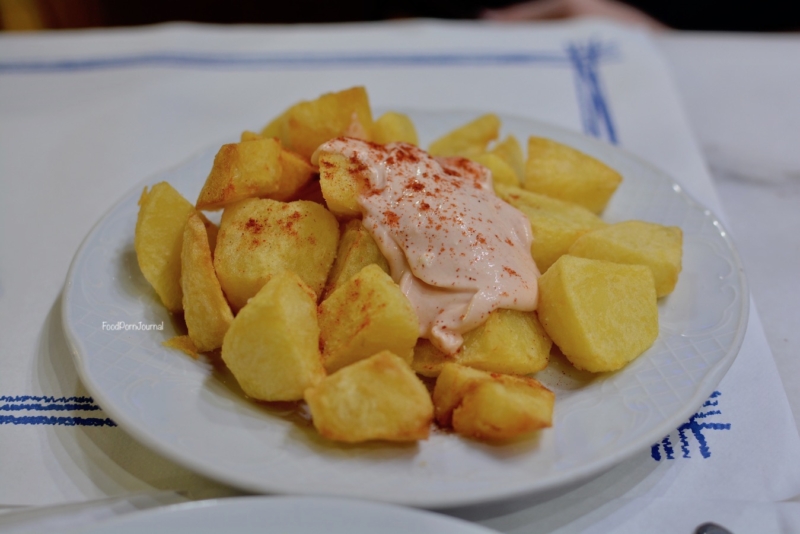
Pastelerias Mauri
The next morning, we had an early 8.00am start at Casa Mila so we had a late breakfast/brunch in the same neighbourhood. I had read that Pastelerias Mauri, a traditional Catalan patisserie and tea house that opened in 1929, was an authentic place to have some pastries. There was so much on display to choose from – pastries, cakes, pasticcini, savoury baguettes, and sandwiches.

The inside of the patisserie is all polished dark timber, old-school charm with a gorgeous painted ceiling. I only managed to capture it on my phone.
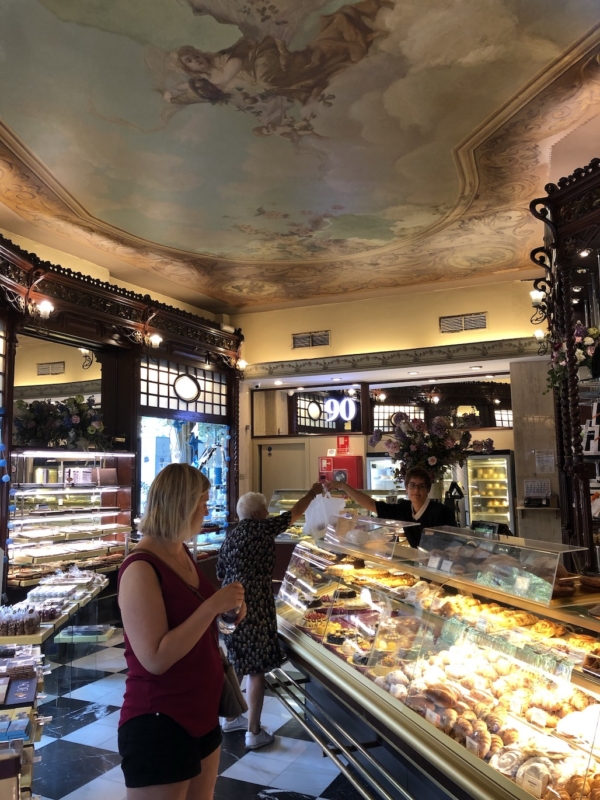
Mr FPJ was happy with the mini baguette stuffed with jamon (2.70€).
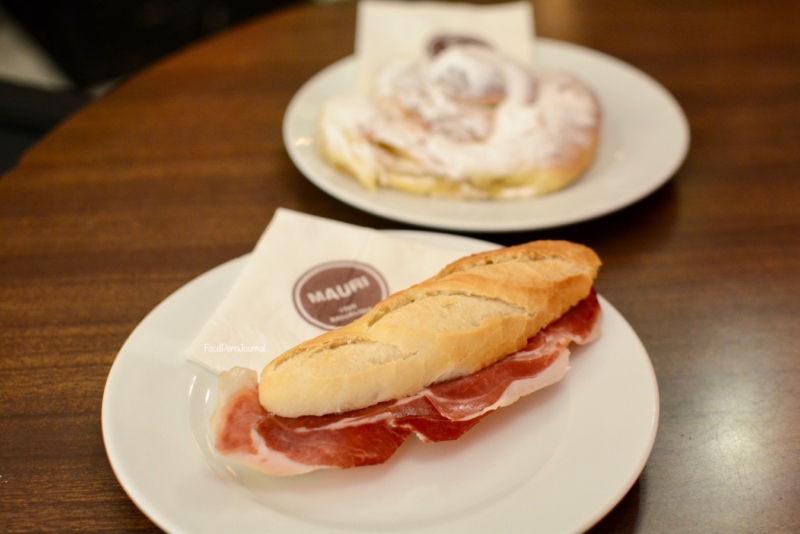
While I picked the ensaïmada farcida angel (2.40€) stuffed with thin strands (aka angel hair) of pumpkin cooked in sugar making it nice and sweet. There was quite a lot of sugary filling so I didn’t manage to eat all of it.
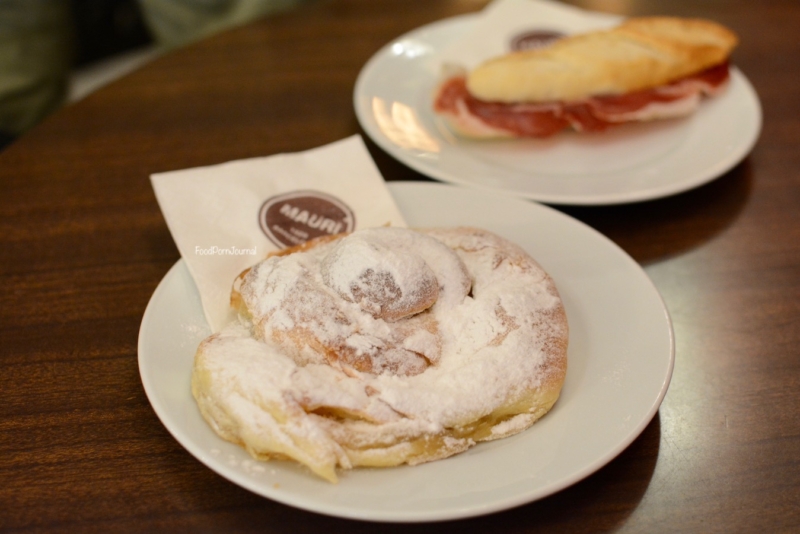
I also couldn’t resist a Spanish hot chocolate! It was deliciously thick as it should be (3.40€).
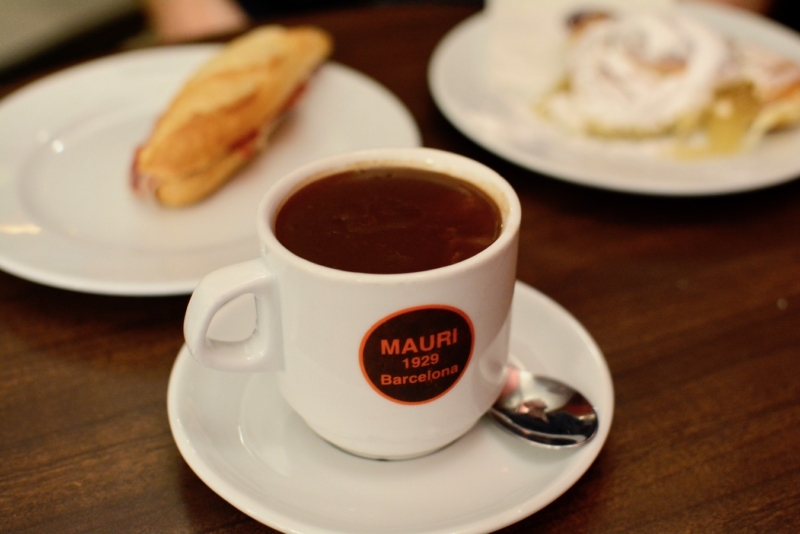
La Bodegueta Provenca
Equipped with some restaurant ideas from Frank Camorra’s Movida’s Guide to Barcelona, we were in the area close to La Bodegueta Provenca and made a stop here for an early dinner (far too early in Spanish time!)
I noticed that tap water is never offered in Spain. Although most public tap water is safe to drink, most people still buy bottled water. This was no problem for Mr FPJ who usually orders beer or wine, but it meant I ended up ordering lots of coca cola light/zeros which were cheaper than water. Mr FPJ ordered a Voll Damm beer (2.70€) while I ordered a coca cola light (2.40€).
We ordered the pa amb tomàquet, or tomato bread (3.60€) after various people telling us that it’s a must try and available at almost all eateries. Served on sliced foccacia, it was like the slightly toasted bread had been dunked face down into tomato puree, then drizzled with oil. So simple but delicious and moreish! It was a great light starter.
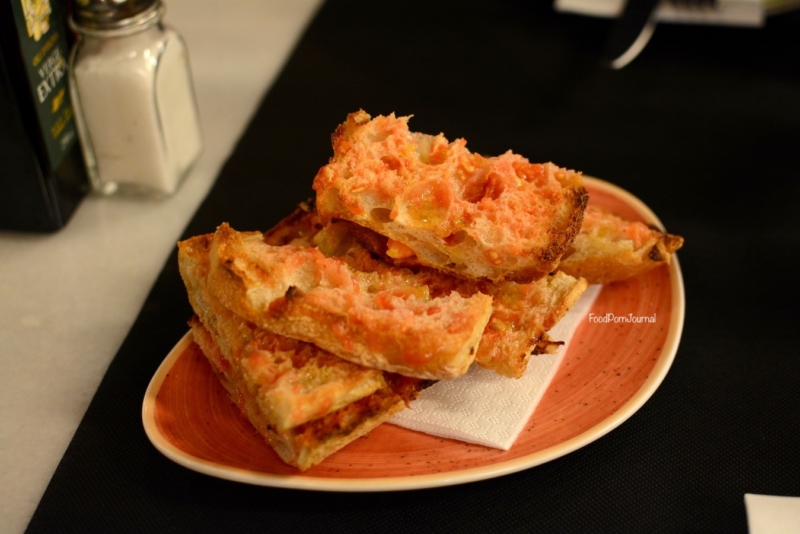
We ordered the grilled clams, coquines a la plancha, (14.90€) in a white wine sauce. There was a bit of work involved to pluck out each individual clam, but they were so tasty!
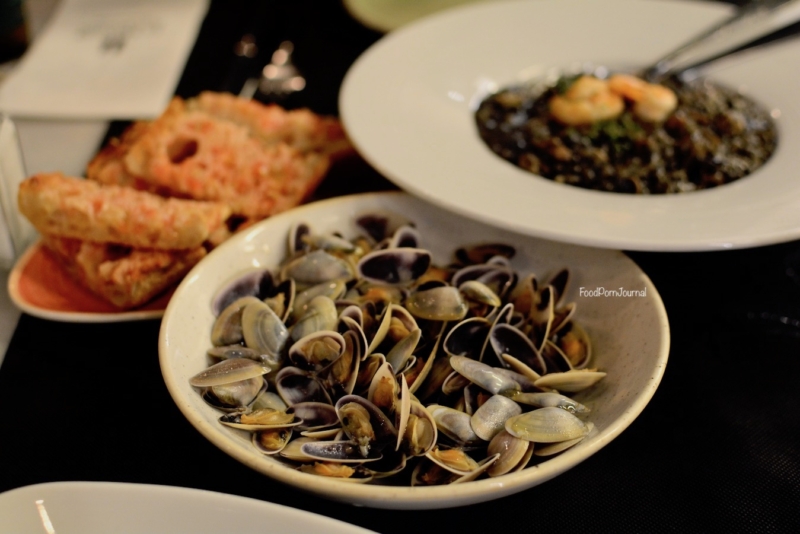
I also needed to try arros negre while in Spain. When I saw it on the blackboard specials, I quickly ordered that too (13.50€). Arros negre is a Catalan dish similar to paella made with cuttlefish or squid. Although quite dark, it wasn’t as rich and intense as anticipated. It was full of seafood flavour, mixed in with diced cuttlefish, and the ink wasn’t too briny. Delicious.
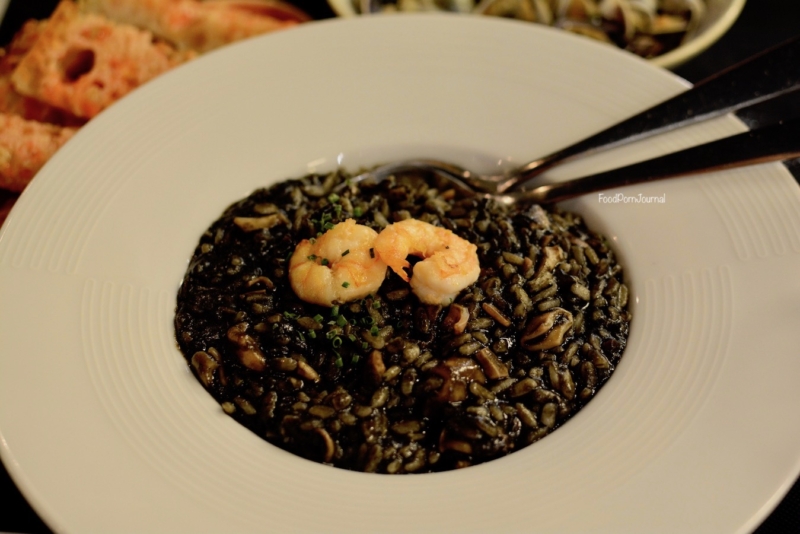
Bar El Velódromo
After an early morning start walking around Park Guell, we caught the metro back towards the Eixample district to walk to Bar El Velódromo for brunch. This is another place in Movida’s Guide to Barcelona which I had marked on my google map since it opened at 6am. I understand it gets packed for tapas in the evening, but since it wasn’t yet midday, it was easy to find a table.
I ordered a Cafe Manolin – basically an espresso with soda as it sounded peculiar. But I honestly couldn’t taste a difference and it just tasted like regular espresso.
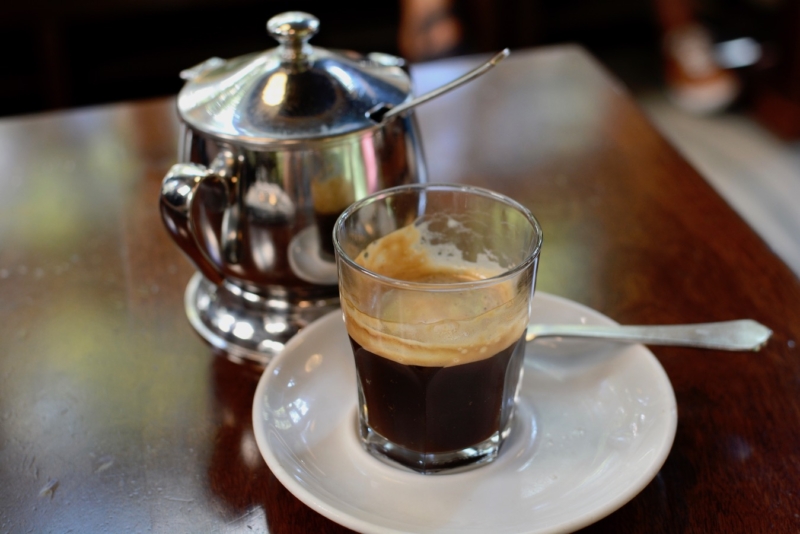
MR FPJ ordered the huevos estrellados – fried potatoes with fried eggs. It was a big portion with plenty of potato and three fried eggs.
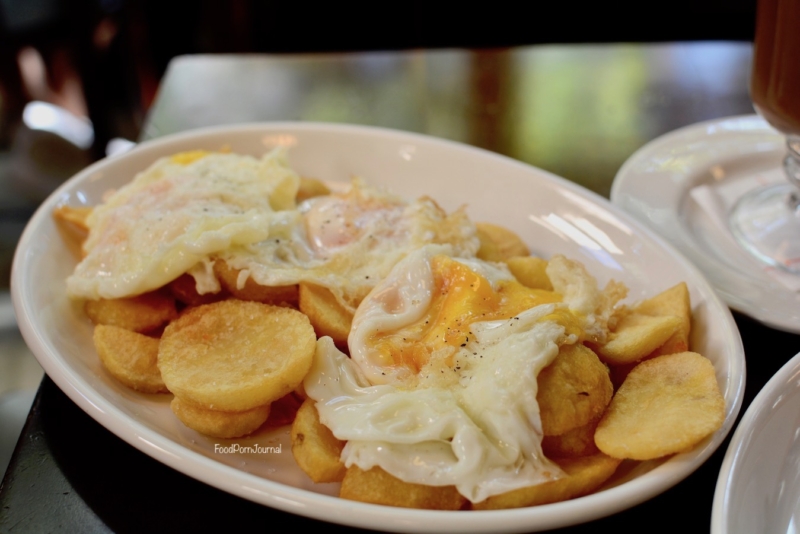
We tried a mini baguette stuffed with butifarra, a Catalan sausage but in this case it was more of a ham.
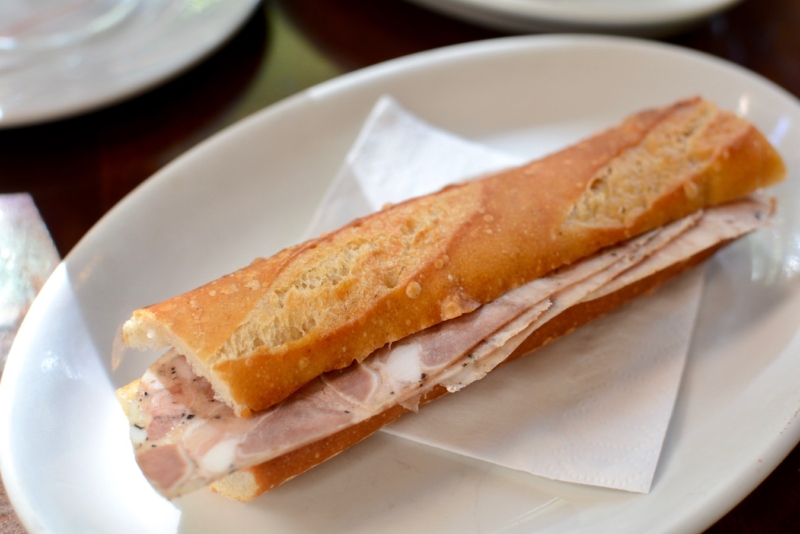
I also couldn’t resist ordering a serve of churros with chocolate.
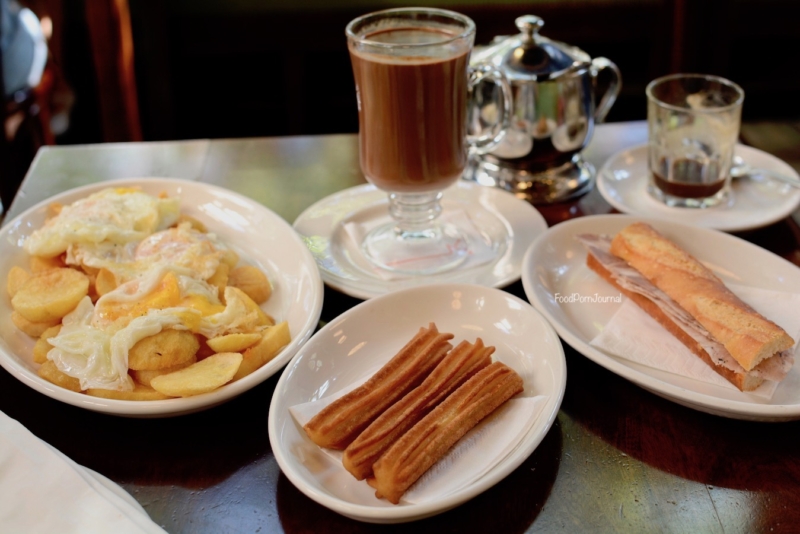
The chocolate came served in a large glass, which I wasn’t expecting, but that is the norm in Barcelona. Mr FPJ calls it a chocolate custard but I love the thickness!
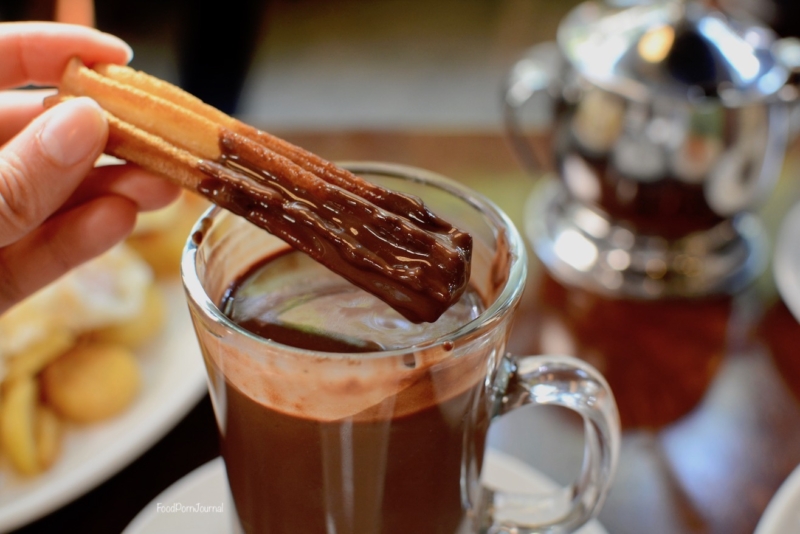
I wish we had more time to go back to Bar El Velódromo for its tapas and other Catalan dishes, but we only had a few days in Barcelona.
On the way back to the metro station, we walked past a tiny bakery selling breads and pastries. Unfortunately, I don’t remember where or what it was called. Mr FPJ was after a pain au chocolat, but the man in front of us purchased the last three. I then spotted miniature croissants and bought one custard and one chocolate one (unsure of price). I took a photo of it in front of Casa Mila (it was a few minutes walk to reach it). Enough for two bites without the calorie guilt.
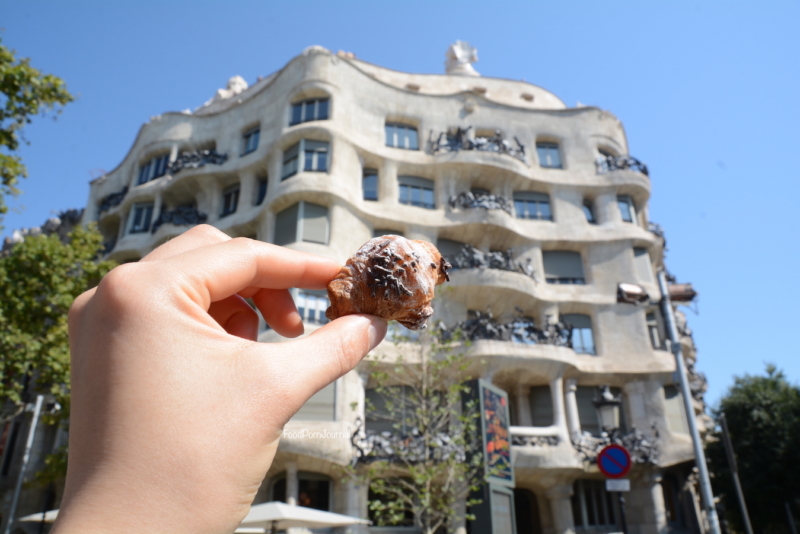
Els 4 Gats
Walking around Barcelona’s Gothic Quarter, we stopped in for lunch at Els 4 Gats. This cafe was frequented by the likes of Picasso and other artists.
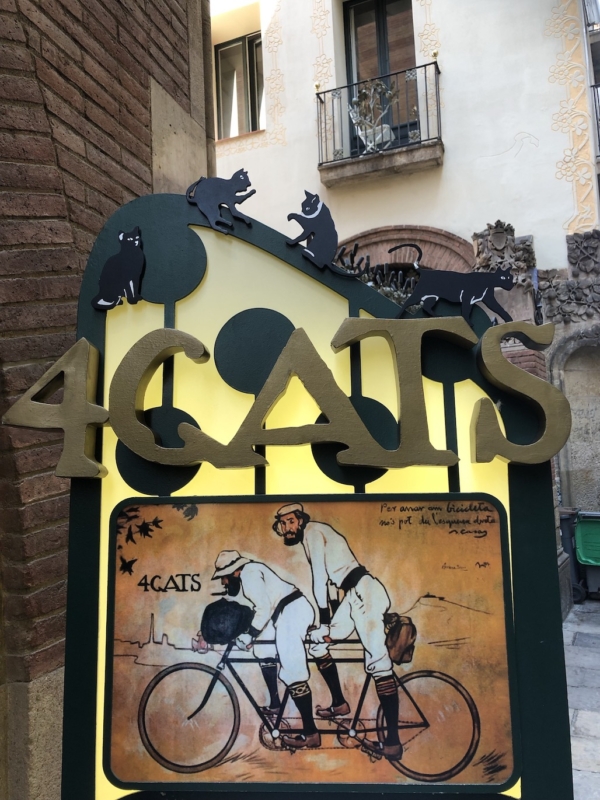
I like the quirky but charming interior. It seems like a nice place to relax and there were quite a few young people reading/working inside.
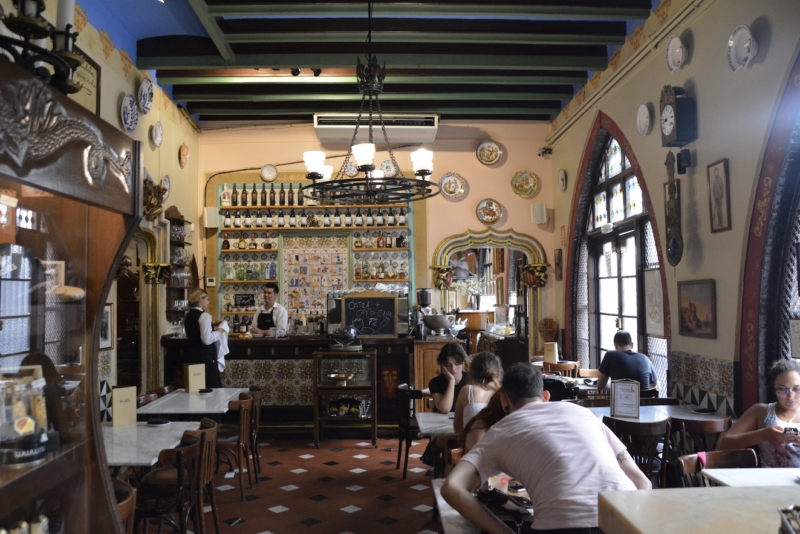
We were seated in the dining area towards the back which was a touch classier than the front room.
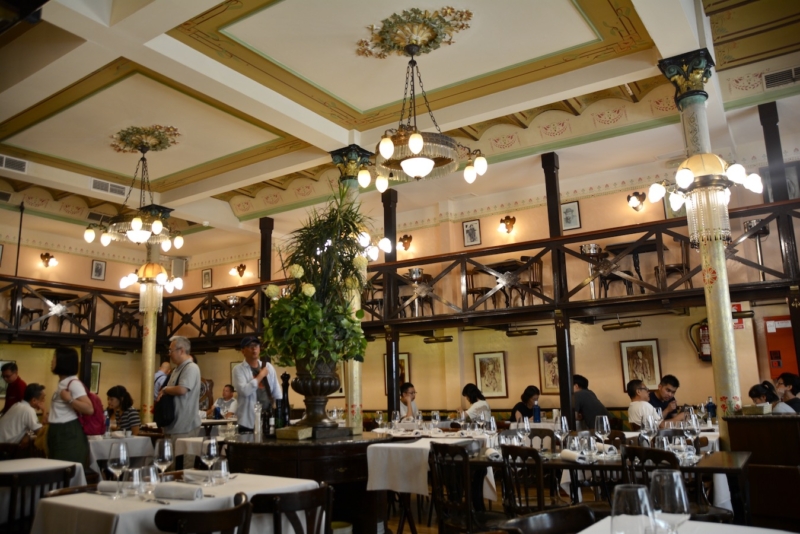
After ordering a wine and our meals, an amuse bouche arrived of a hummus dip with mini carrot stick.
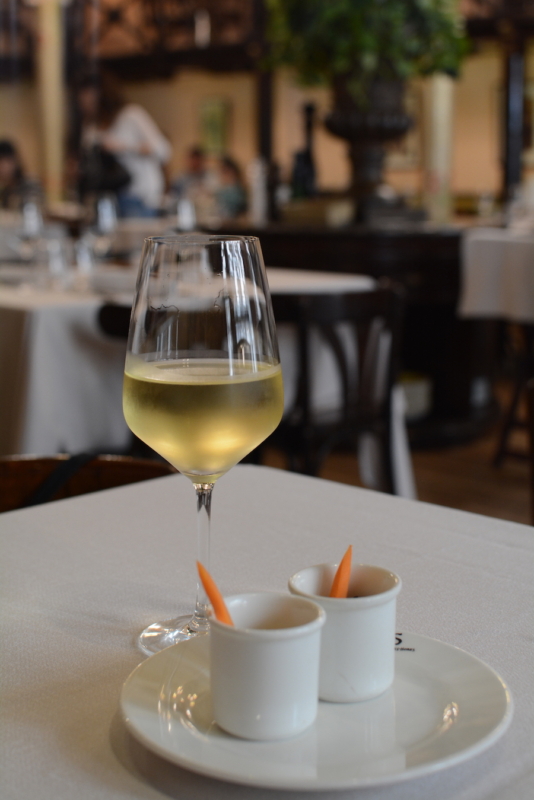
Far too much hummus to carrot stick ratio, but we weren’t expecting an amuse bouche so it was a nice way to start our lunch.
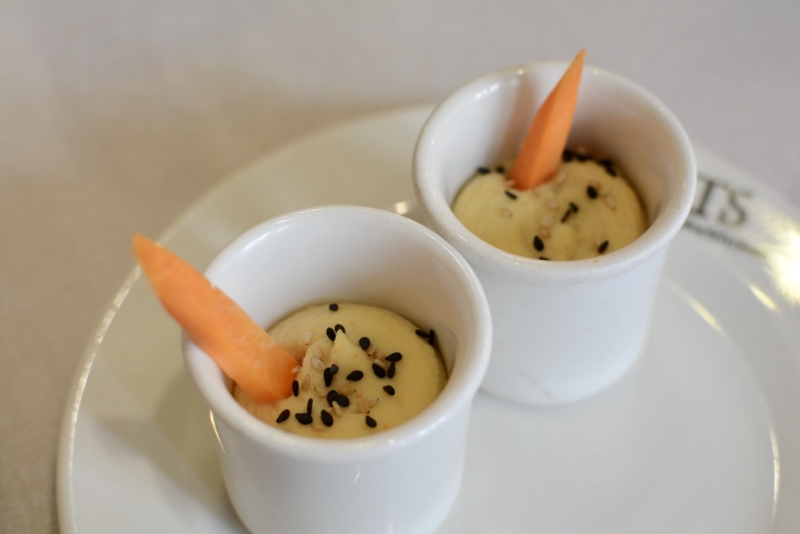
We ordered the tomato bread (4€) served on a more thin and crispier bread than at La Bodegeuta Provenca. We preferred the fatter foccacia version as it seemed to keep the tomato and tomato juices from spilling.
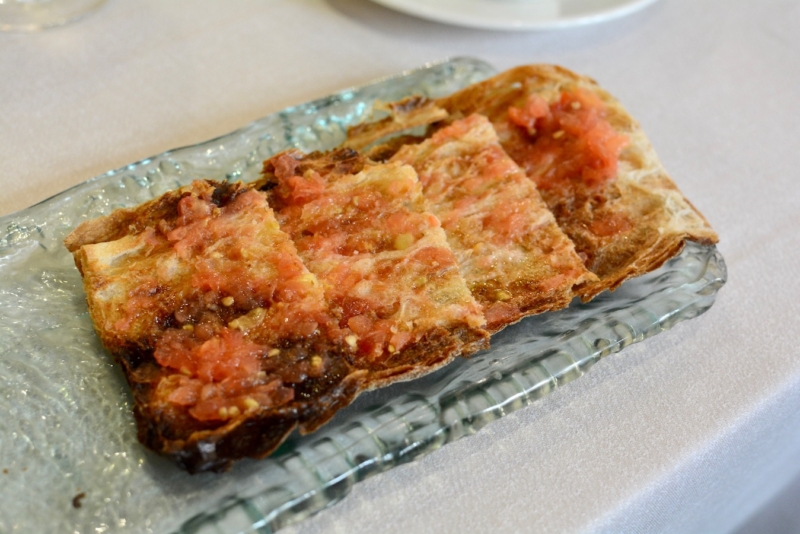
I ordered the Arrosejat noodles (unsure of price) with cuttlefish, prawns and mussels. This is similar to paella, except instead of rice, they use short noodles. The arrosejat is made for 2 people and I’m glad we didn’t order anything else as it was such a big portion. You can’t tell from the photo but the pan is very large and takes up half the table. Lots of flavour, a tad salty, but with lots of little chunks of seafood throughout. We didn’t finish it all.
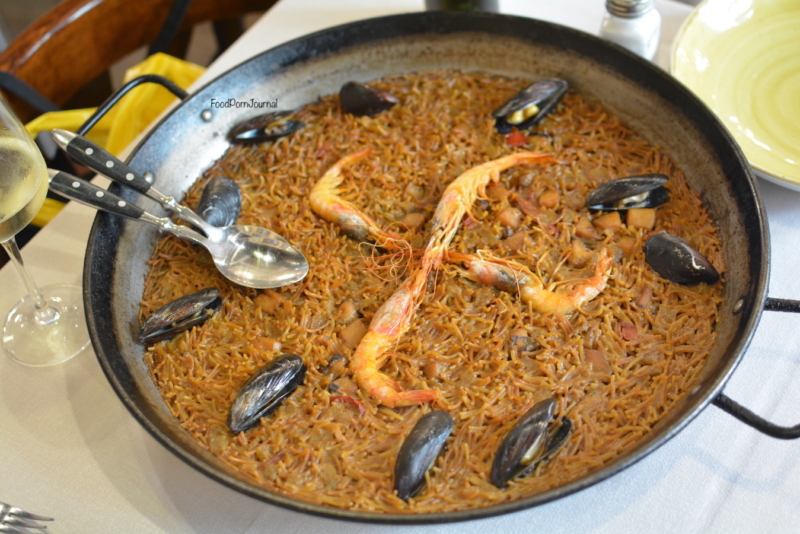
Pastisseria La Colmena
Being such a sweet tooth, I scoped out a few patisseries around Barcelona. Pastisseria La Colmena, opened in 1868 and have been open for business for 150 years! It was close to Els 4 Gats in the Gothic Quarter, so we slowly wandered there after our lunch.
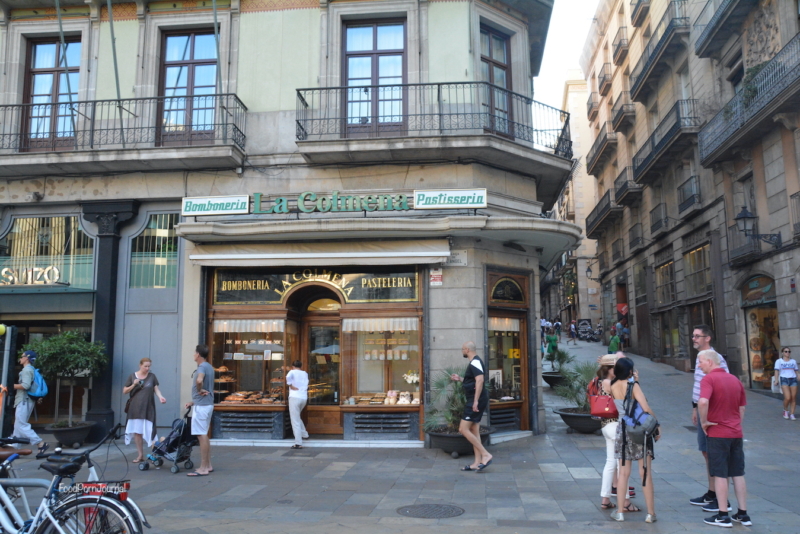
La Colmena is one of the oldest cake shops in Barcelona, selling a range of goodies. I stood at the two front windows salivating at all the items.
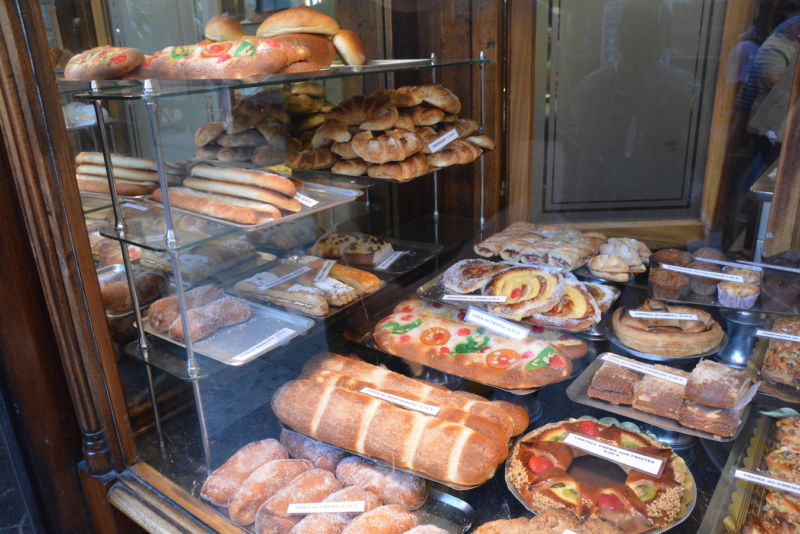
Quick video of the pastries below
There was a range of meringues, candies, and biscuits in the other window too.
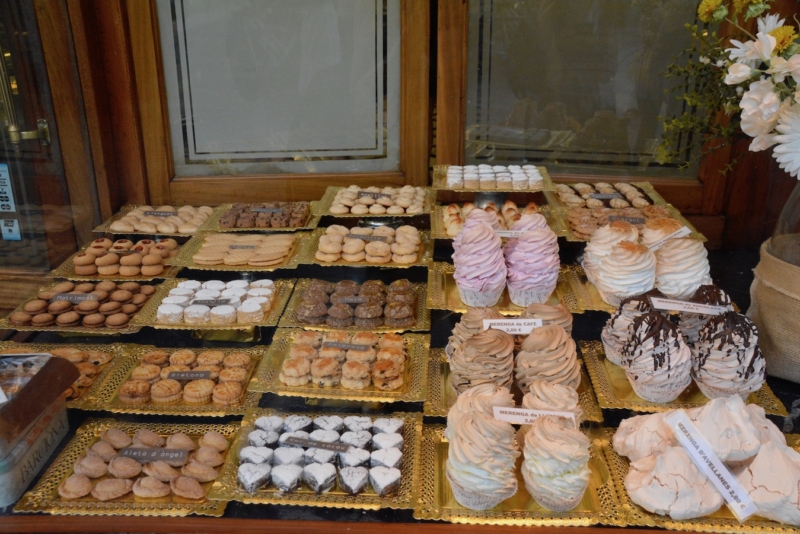
Inside, there are more display counters filled with sweet treats like the one below of chocolate truffles and biscuits. There were also panellets (a Catalan biscuit made for the All Saints festival), bolados (a classic sweet served in the 18th century), and more.
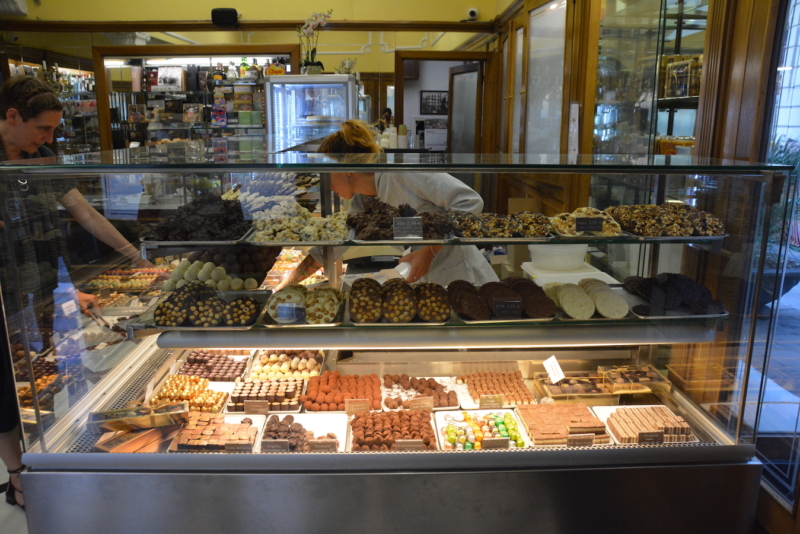
We were still so full after lunch so I couldn’t buy any large pastry (as much as I wanted to!) and took my pick of a few pasticcini-esque items instead (at 48€ per kg) to have later that night.
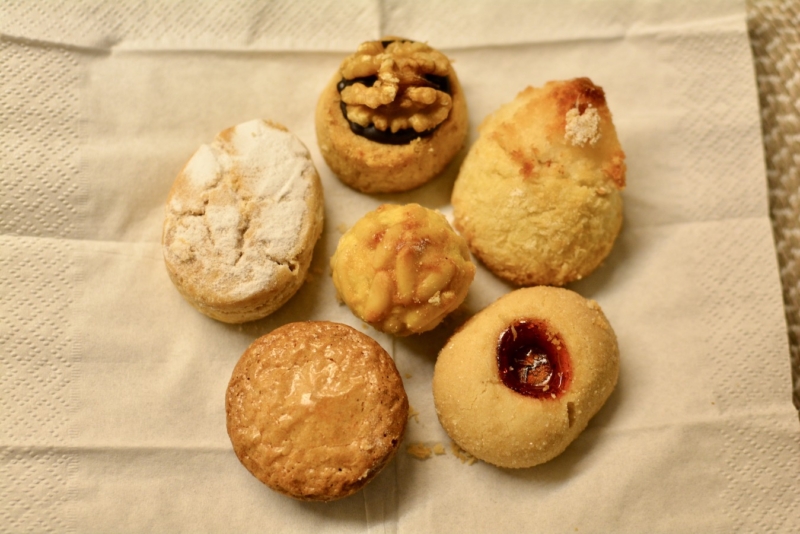
Bar Lobo
Bar Lobo was only a few metres away from our hotel, and we literally walked past each day and night. It was always packed with people and in a nice little spot away from La Ramblas, so we decided to have an early dinner there to secure an outdoor table. The menu is split into a range of tapas, ham/cheese/sausages, light dishes, and main courses. Mr FPJ started off with a house made sangria (6€).
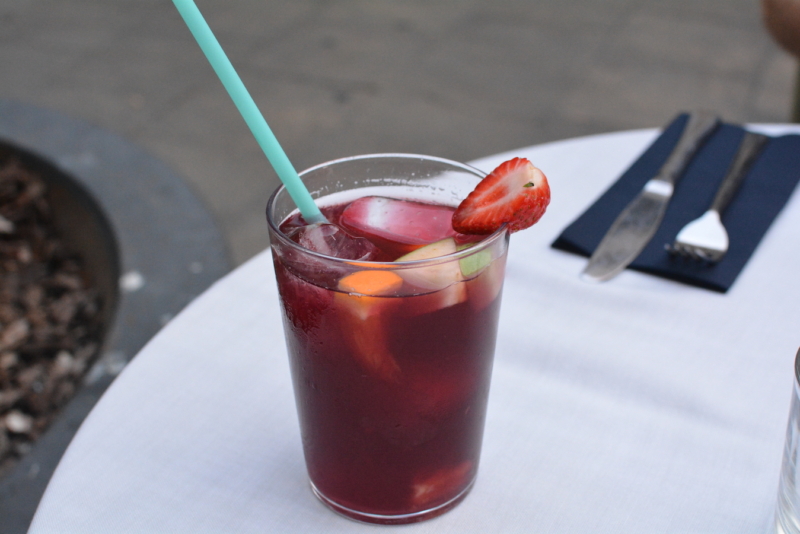
I decided to stick to the tapas menu so we could try more dishes. Since we both love tomato bread, we started off with a serve of tomato bread (2.50€) and jamon croquettes (5€).
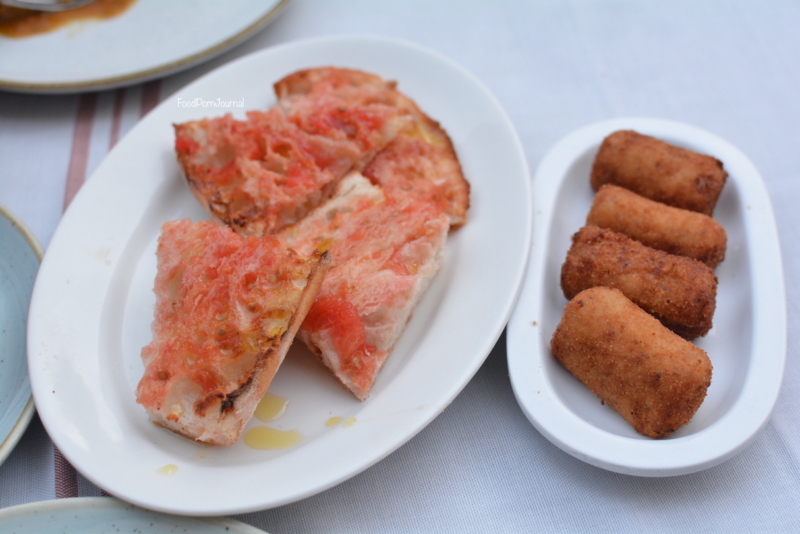
We asked the waiter what else he recommended and he mentioned the meatballs with squid and porcini (9.60€) was a favourite, so we decided to try that. It was divine and I’m grateful we had asked for a recommendation. I don’t know what was in the sauce, but it needs to be bottled up and sold. I was surprised to see whole calamari rings and large slices of porcini mushrooms as standalone items (I thought they would be stuffed into the meatball). A simple dish but done so well. We used some bread to mop it all up.
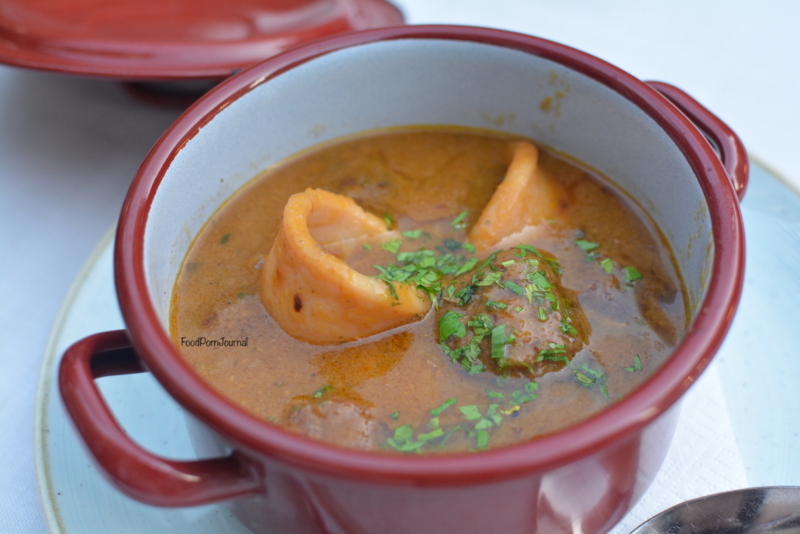
I also ordered the ceviche de corvina (11€) with avocado, onion and coriander for something fresh and zesty.
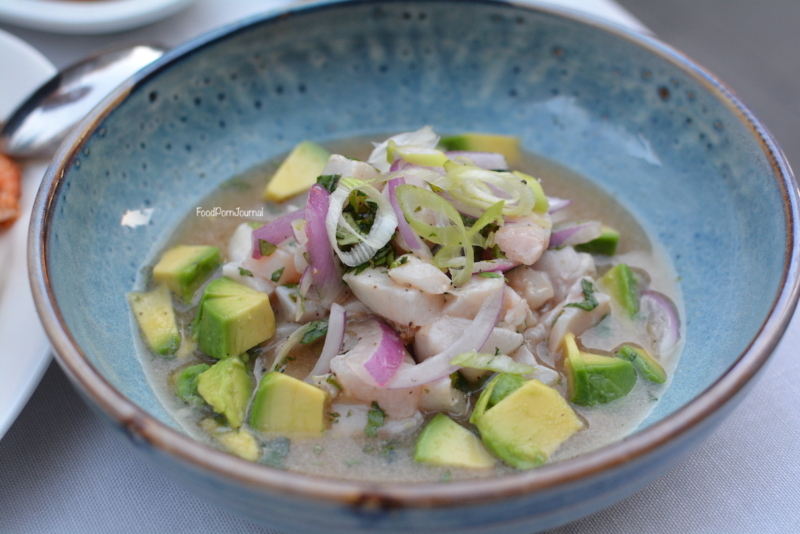
It was lovely sitting outside enjoying the warmth (without the sharp heat from the sun) and people watching. A busker had set up to play some music, and then came around with a cap asking for money. That got annoying after two songs and ruined the ambiance for us, so we asked for the bill and left. Apart from that, the prices are actually reasonable and the food was great.
More on Barcelona in the next chapter…
Eateries visited:
- La Viena Blanca – Pintor Fortuny, 10, 08001 Barcelona
- Pastelerias Mauri – Carrer de Provença, 241, 08008 Barcelona
- La Bodegueta Provenca – Provença, 233, 08008 Barcelona
- Bar El Velódromo – Carrer de Muntaner, 213, 08036 Barcelona
- Els 4 Gats – Carrer de Montsió, 3, 08002 Barcelona
- Pastisseria La Colmena – Plaça de l’Àngel, 12, 08002 Barcelona
- Bar Lobo – Carrer del Pintor Fortuny, 3, 08001 Barcelona
If you want more random photos and updates about food, I’m on Facebook, Twitter and Instagram
Facebook: /foodpornjournal
Twitter: @foodpornjournal
Instagram: /foodpornjournal

gsteele531
September 18, 2021 at 7:18 am (4 years ago)I lived in Madrid for several months in 1969-1970. In those days, Spanish currency was the Peseta – 70 to the dollar. I lived in the old section of town, South and West of the Prado and Plaza de las Cortes, and frequented the local restaurants and bars on Calle Victoria, where you bought tickets for the bullfights, and strolled the streets at night with local families.
All in – room, breakfast, lunch, dinner, and a few chatos of wine at night listening to neighborhood musicians at a local bar – cost me less than a dollar a day. Room – 25 ptas; Chocolate con churros for breakfast – 5 ptas; Bocadillo de Jamon for lunch – 8 ptas; a paella for dinner on paella night (discount) – 15 ptas, topped off with 3 ptas for a flan and a duro for the waiter; and wine about 3 ptas/glass including a little tapa. Throw in a duro (5 ptas) or two as tips for the musicians when they passed the hat.
A full, multi-course filete de cerdo or ternera (pork or veal) meal with Sangria and melocoton en almibar dessert was about 25 ptas, and a special dinner at Sobrino do Botin of Cochinillo – roast suckling pig the way Papa Hemingway liked it – was an overpriced extravaganza at 100 ptas (that’s about $1.40); I splurged only once. A duro when you came back to the Pension to get the door unlocked by the Sereno, who had all the keys to the doors on the street.
On a hot day, a little store on Puerta del Sol that sold Trufas Heladas – icy cold, chocolate covered balls of goodness – was a refuge that made you wish for more hot days. Very easy to end the day with change left over from 70 ptas. Very different from the multi-Euro prices shown above – although Barcelona was always more expensive than Madrid, by far. Your food travelogue brought back many happy memories, from a half-century ago.
FoodPornJournal
September 20, 2021 at 10:57 am (4 years ago)I can’t even imagine what Spain would have been like in the 60s! They sound like such wonderful memories, thank you so much for sharing 🙂 Glad I was able to help with reminiscing 🙂